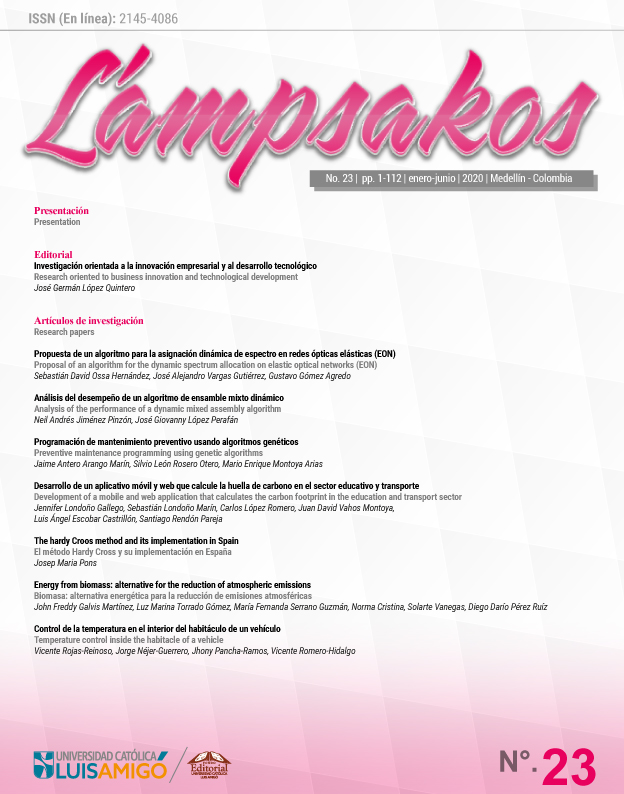Temperature control inside the habitacle of a vehicle
DOI:
https://doi.org/10.21501/21454086.3462Keywords:
Heat, Latent Heat, Sensitive Heat, Temperature, Heat Transfer, Automation, Automatic Control, Electronics, Electronic Circuit, Climate Control, Air Flow.Abstract
The present work analyzes the variables that influence the thermal gradient of the passenger compartment in vehicles; the parameters of the elements are established in order to determine the transfer function of the system, managing to maintain
temperature control in said space; the electronic circuit operates based on parameters and data obtained from devices installed, which allows to maintain a comfort temperature suitable for the clarity of the driver and occupants, reducing heat stress and avoiding possible traffic accidents occurring frequently on country roads.
The main objective to optimize driving conditions are heated systems that also allow temperature stabilization operation of the vehicle, also achieved when the same be steady in all conditions; because in this way, you can reduce the risk to health and therefore the management by the driver and occupants.
Downloads
References
ASHRAE, Thermal Enviromental Conditions for Human Occupancy. Atlanta: ANSI/ASHRAE, 2013.
F. P. Incropera, y D. P. De Witt, Fundamentos de Transferencia de Calor; 4ta edición, Prentice Hall, 1999.
ASHRAE, 2013, Part 55-103 Norma 55-103. Thermal enviromental conditions for human occupancy.
F. J. Chávez del Valle, Zona Variable de confort térmico. Universitat Politécnica de Catalunya, 2002.
D. A. Peláez, Técnicas del automóvil: sistemas de climatización. España: Paraninfo, 2003.
M. Mazzone, Controladores PID. Universidad Nacional de Quilmes, 2002.
Tsai, H. L., & Lin, J. M. (2010). Model building and simulation of thermoelectric module using Matlab/Simulink. Journal of Electronic Materials, 39(9), 2105. Vol. 39, No. 9, 2010 DOI: 10.1007/s11664-009-0994-x
Ogata, K. (2010). Ingeniería de control Moderna (5ta. Ed.). Madrid, España: Pearson Educación.
R. J. Betancourt Maldonado, y F. G. Flores Piña, “Diseño y construcción de un módulo didáctico de control de temperatura”, Tesis, Escuela Politécnica Nacional, Ecuador, 2009.
Bosh, Manual de la Técnica del Automóvil. Reverte, 1999.
Pérez, M. A., Baltazar, V. B., Ramírez, J. P., & Valle, F. M. (2014). Diseño de controladores P, PI y PID para el comportamiento dinámico de un servo-sistema hidráulico, basado en desarrollo experimental. Investigación, 2(16), 21.
Downloads
Additional Files
Published
How to Cite
Issue
Section
License
In accordance with national and international copyrights, as well as publishing policies of "Fundación Universitaria Luis Amigó" and its Journal "Lámpsakos" (indexed with ISSN : 2145-4086), I (we ) hereby manifest:1. The desire to participate as writers and submit to the rules established by the magazine publishers.
2. The commitment not to withdraw the manuscript until the journal finishes the editing process of the ongoing issue.
3. That article is original and unpublished and has not been nominated or submitted together in another magazine; therefore, the rights of the article in evaluation have not been assigned in advance and they do not weigh any lien or limitation for use.
4. The absence of conflict of interest with commercial institution or association of any kind
5. The incorporation of the quotes and references from other authors, tending to avoid plagiarism. Accordingly, the author affirms that the paper being published do not violate copyright, intellectual property or privacy rights of third parties. Morover, if necessary there is a way of demonstrating the respective permits original copyright to the aspects or elements taken from other documents such as texts of more than 500 words, tables, graphs, among others. In the event of any claim or action by a third party regarding copyright on the article, the author (s) will assume full responsibility and come out in defense of the rights herein assigned. Therefore, for all purposes, the Journal "Lámpsakos" of the "Fundación Universitaria Luis Amigó" acts as a third party in good faith.
6. In the event of the publication of the article, the authors free of charge and on an exclusive basis the integrity of the economic rights and the right to print, reprint and reproduction in any form and medium, without any limitation as to territory is concerned, in favor of the Journal "Lámpsakos" of the "Fundación Universitaria Luis Amigó".








